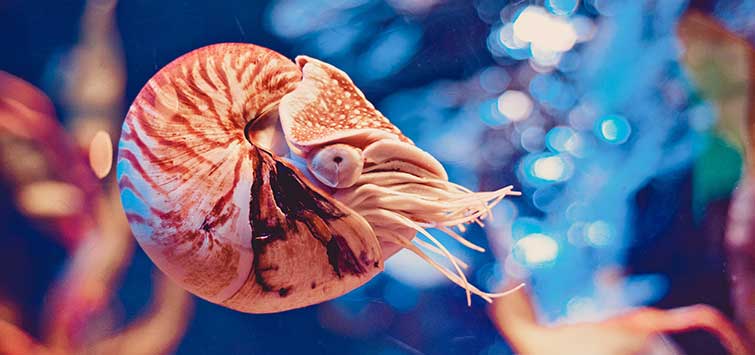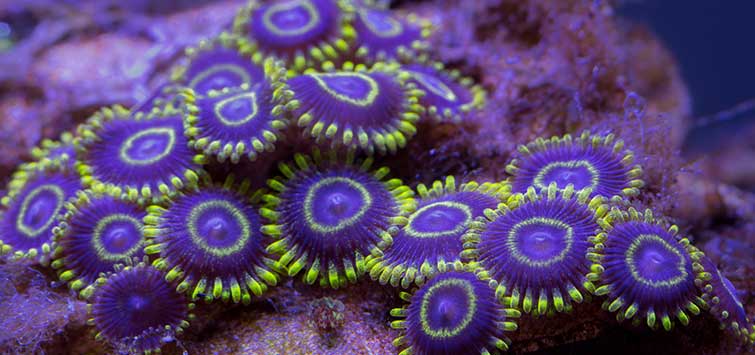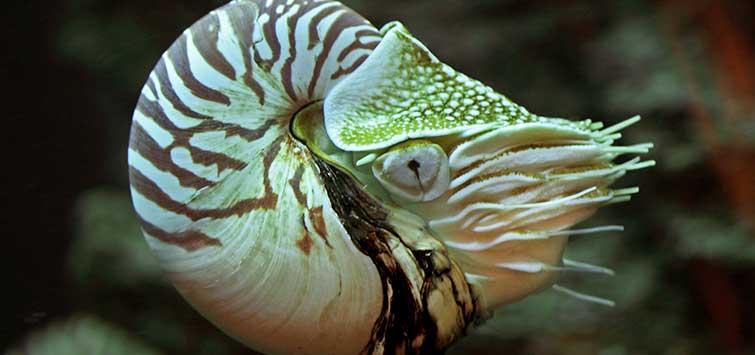Aquarium Science: Husbandry of the Nautilus: Aspects of its Biology, Behavior, and Care
Author: Adam Daw and Gregory J. Barord
A scientific look at the unusual nautiluses, including their eating habits, reproduction, and famously unique anatomy.
Keeping Cephalopods
The common misconception regarding the captive care of cephalopods is that long-term success is impossible. While it is true that keeping cephalopods is a difficult task, understanding their biology and natural behavior will enhance the success of the exhibition of these animals. The nautiluses are no exception. Though they may not have the chromatophores possessed by other cephalopods that enable color change, these deep-sea animals are a window into a world that most people will never see.
The nautilus differs from other cephalopods in many aspects both anatomically and behaviorally. The main body features of the nautilus are its shell, hood, and tentacles.
Shell and Hood
Similar to the cuttlebone in cuttlefish, the nautilus shell regulates the animal’s buoyancy, while at the same time providing protection against predators. The calcium carbonate shell is made up of individual chambers, some of which are filled with gas and others filled with seawater. The chambers are interconnected by a tube, or siphuncle. The liquid-filled chambers release or take in sea water in order to maintain neutral buoyancy.
The body of the nautilus lies within the first chamber and can retract into this chamber if in danger. In the retracted state, the hood protects and conceals the animal from predators. This behavior is its only known defense mechanism. While most cephalopods possess an ink sac that can be used as a defensive tactic, the nautilus is without an ink sac.
Tentacles
Nautiluses are equipped with a total of 90 adhesive tentacles, without suckers, significantly more than any other cephalopod. Utilizing its 90 tentacles, the nautilus is able to feel around the ocean floor or rocks searching for prey. Vision in the nautilus is much less developed than in other cephalopods; the eye lacks a lens and is constructed like the aperture of a pinhole camera (Hanlon & Messenger, 2005).
The last major difference between nautilus and other cephalopods is their life span. While most cephalopods have a life span of one to two years, the nautilus is thought to live up to at least 15 years, a very attractive characteristic for an aquarium animal.
Feeding
Wild nautiluses have been observed to make diel migrations (Carlson et al., 1984; Ward et al., 1984). This type of behavior takes the nautilus from depths of 1200 feet at daybreak up to depths of 300 feet by sunset. Nautiluses can best be characterized as opportunistic feeders investigating food when detected. The actual feeding behavior of the nautilus can be described as sampling, searching, and sweeping.
There is evidence to support that the nautiluses detect prey by sampling lateral currents across the reef for chemical trails (O’dor et al., 1993). After detecting prey with the use of large olfactory organs, the tentacles are used to locate and seize the prey. The diet of the wild nautilus includes crustaceans (including hermit crabs; Ward & Wicksten, 1980), crustacean molts, nematodes, echinoids, and fishes (Saunders & Ward, 1987). There are accounts of cephalopod beaks and nautilus tentacles found in the gut as well (Hanlon & Messenger, 2005). It is not uncommon under aquarium conditions to witness cannibalism (Carlson, 1987) as is observed with other species of cephalopods.
The main focus in the feeding of nautiluses is to provide food that is high in calcium in order to sustain normal shell growth. The most common food offered to nautiluses in captivity is shrimp (with shell), squid, various types of frozen fish, and blue crab. Several different types of molts, such as lobster molts, have also been fed as an enrichment food. The lobster molt is taken quickly and consumed with no problems (molts are also a great source for calcium).
Shell Aberrations
A common and still misunderstood issue with captive nautiluses is aberrations of the shell. Over time, the shell does not grow normally and begins to degrade. Signs of this are black edging of the newly formed shell. There appears to be no adverse health issues associated with the shell malformation, and to date is merely an aesthetic problem.
Aquarium Care
Tank Size
Although nautiluses spend most of the time attached to the walls of the aquarium, they do occasionally jet around with minimal control, often running into the sides of the tank. For this reason the dimensions of their accommodations are important for the proper care and maintenance of nautiluses. For the average nautilus (less than 6 inches), the aquarium should be at least 3 feet long, 18 inches wide, and 2 feet deep to allow the animal to move around freely without constantly bumping into the sides of the tank; however, when keeping multiple nautiluses or a single large nautilus, a bigger aquarium is required.
Filtration
As with all cephalopods, a key ingredient in successful husbandry is proper filtration. Due to the high amount of solid and liquid waste produced, it is important to have a large biological filter bed or sand filter. A protein skimmer is also recommended to help manage the large waste load. UV sterilizers can be added to help minimize the spread of possible pathogens, which can be difficult to treat in cephalopods. A good rule to go by is to have a filtration system that is designed for a tank twice the size of the one the animal is in.
Temperature
Another important aspect of keeping nautiluses alive is maintaining the water temperature between 50° and 70°F, using a chiller. For a more natural environment and to aid possible breeding, one can have the temperature gradually fluctuate between cooler and warmer temperatures over a 24-hour period. This will mimic diel migration, although this will be difficult without a computer controlling the heater/chiller. Because nautiluses live in the deep sea and receive only minimal light when migrating to the surface at night, there should only be enough light in the tank to view the animal. Actinic lights work well for this, as too much light can stress the animal.
Aquascaping and Tankmates
Careful consideration should be used when deciding how to decorate the tank and choosing tankmates. Live rock can be used on the bottom and sides of the tank, but the mid and upper sections of the tank should be clear of obstacles that the nautilus could run into and damage itself. There should be no plastic dÉcor, as nautiluses have a habit of trying to bite/eat everything.
The nautilus is one of the few cephalopods with which other animals have been kept in the same tank with some success, but keep in mind that there is always the chance that those animals could become a snack. If choosing to have tankmates, make sure they are non-aggressive and can withstand the cold water and dim lighting nautiluses require. Possible tankmates include cardinalfish, squirrelfish, pinecone fish, flashlight fish, shrimp, sponges, snails, and non-stinging corals that can live in low light.
Reproduction
The understanding of nautilus reproduction has increased substantially in the past 20 years owing much to the pioneering work of Dr. Bruce Carlson at the Waikiki Aquarium (Carlson, 2000). There are two methods in determining the sex of a nautilus.
The first is best used on new animals not accustomed to captivity. By turning the animal upside-down, a horseshoe-shaped gland will be visible in females and will be green to brown in mature females. This technique, though, should only be used by advanced aquarists.
The second technique of sexing a nautilus is to locate the spadix, which is a large modified tentacle found on the left side of the male nautilus, adjacent to the mouth. The spadix is the mode of sperm transfer.
Nautiluses mate facing each other and may stay in that position for hours. The first embryo was discovered in 1985 and the first hatchling was obtained in 1988 (Norman, 2000). In captivity, female nautiluses may lay one to two eggs per month. The nautilus egg will take at least one year to hatch. The temperature of the egg-holding tank is crucial in the development of the embryo.
While most nautiluses are kept at temperatures of 64°F, the eggs actually develop at warmer temperatures, 70° to 75°F. Once hatched, the juvenile nautilus readily accepts food. Unfortunately, there has been no success in rearing adults from eggs as of yet.
Difficult but Rewarding
The task of exhibiting the nautilus can be very overwhelming when considering tank design, filtration units, and tank decor. Nevertheless, a keen awareness and understanding of nautilus biology and behaviors will assist you when you begin to assemble your tank. As Jacques Cousteau said, “The impossible missions are the only ones which succeed.”
References
Carlson, B. A., McKibben, J. N., & DeGruy, M. V. 1984. “Telemetric investigation of vertical migration of Nautilus belauensis in Palau.” Pacific Science 38:183–188.
Carlson, B. A., 1987. “Collection and aquarium maintenance of Nautilus.” In Nautilus: The Biology and Paleobiology of a Living Fossil. Plenum Press. New York, NY. pp. 563–578.
Carlson, B. A., 2000. “Breeding chambered nautiluses.” In Cephalopods: A World Guide. ConchBooks. Hackenheim, Germany. pp. 24–29.
Hanlon, R. T. & Messenger, J. B. 2005. Cephalopod Behavior. Cambridge University Press. Cambridge, United Kingdom.
Norman, M. 2000. Cephalopods: A World Guide. ConchBooks. Hackenheim, Germany.
O’dor, R. K., Forsythe, J., Webber, D. M., Wells, J. & Wells, M. J. 1993. “Activity levels of Nautilus.” Nature 362:626–627.
Saunders, W. B. & Ward, P. D. 1987. “Ecology, distribution, and population characteristics of Nautilus.” In Nautilus: The Biology and Paleobiology of a Living Fossil. Plenum Press. New York, NY. pp. 137–162.
Ward, P. D., Carlson, B. A., Weekly, M. & Brumbaugh, B. 1984. “Remote telemetry of daily vertical and horizontal movement of Nautilus in Palau.” Nature 309:248–250.
Ward, P. D. & Wicksten, M. K. 1980. “Food sources and feeding behavior of Nautilus macromphalus.” The Veliger 23:119–142.

.png?h=595&iar=0&w=2781&hash=5FD5E69473BCC22199FBFA2FB71B6033)



